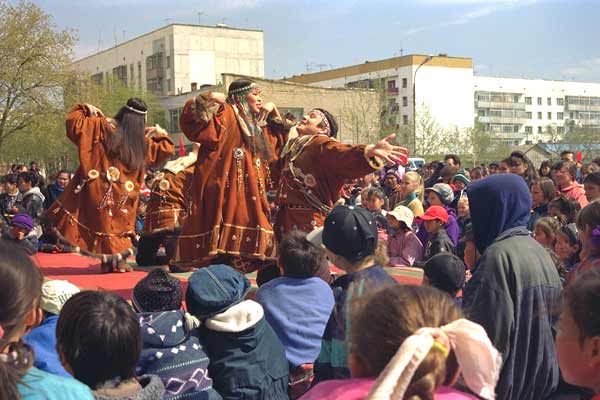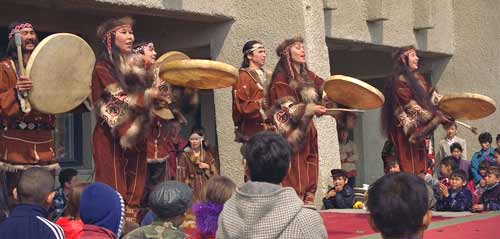
Nearly everyone who is physically capable enjoys dancing in Kamchatka. Dancing styles are usually classed as being representative of a culture. Disco dancing is "western" or "Russian," although Russian folk dance is also appreciated. Koryak dance styles are especially popular, however. Koryak dance moves are dramatic: kicks, high jumps, combined with drumming. There have been ethnic dance ensembles in Kamchatka since the 1930s, but their number greatly increased with perestroika, and especially so in the 1990s. They come out of Soviet "house of culture" organizations. These are community arts centers, where artists are employed to put on professional shows and lead local people in amatuer productions. Many dance ensembles stage dances which are representative of all of Kamchatka's indigenous groups: Chavchuven, Nymylan, Chukchi, Itelmen, Even, and Aleut.
Mengo is the first, and to date only, fully professional ethnic dance group in Kamchatka. Mengo started in the 1960s as an informal gathering of native intelligentsia in the Palana house of culture. It quickly gathered support, and soon a young man from Ukraine came to direct the group. Mengo was reorganized into a professional ensemble under the auspices of the Okrug Department of Culture in 1974 (Zhornitskaia 1983: 145). The Ukrainian Alexander Gil was a professionally-trained ballet master, and he gave his personal, artistic stamp to Mengo so that over ten years after his death, the name “Gil” is still synonymous with Mengo’s art. His name graces one of Palana’s two paved streets. Below are pictures taken in June 1997 during a performance in the main square of Palana.

Sealskin adorns the costumes of Mengo in this dance called "Little Aleut Girl." It is based upon Aleut dance traditions as found on the Commander Islands, just a little to the east of Kamchatka. The costumes evoke an Aleut style. The dance moves imitate the moves typical of walruses, which are also symbolized by the large mustaches on the men. The man in the middle with his hair in a a 'top knot' plays the role of a young male walrus trying to gain the affections of the females, much to the displeasure of the males.
Follow this link for a QuickTime movie clip of this dance (2.6 megs), which will open in a new window.


 Looking
closely, one can see the reindeer herder's lasso coiled around the man's torso
and over his shoulder. Mengo has several dances based on traditions of reindeer
herding Koryak people, also called 'Chawchu' ("Chavchuven" by Russian
speakers), which is usually translated as "rich in reindeer." These
dances are some of Mengo's most popular.
Looking
closely, one can see the reindeer herder's lasso coiled around the man's torso
and over his shoulder. Mengo has several dances based on traditions of reindeer
herding Koryak people, also called 'Chawchu' ("Chavchuven" by Russian
speakers), which is usually translated as "rich in reindeer." These
dances are some of Mengo's most popular.
Here is a clip of the dance "Norgoli," which describes the scene of a reindeer herders' annual fair and ritual meeting between maritime hunting people and nomadic reindeer herders for trade, games, feasting, and fun. (4.83 megs, opens in new window).

Drums are a main feature of many dances in the Mengo repetoire.
Drummers' Dance has many energetic leaps, considered typical of reindeer herders' dances in the north.
Drummers' Dance (3.21 megs in new window).
Page Date: November 4, 2003